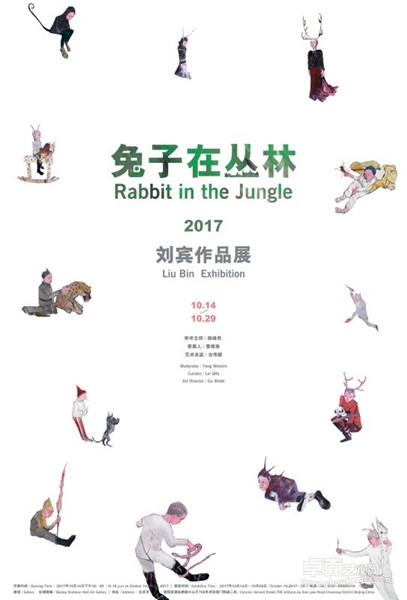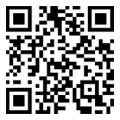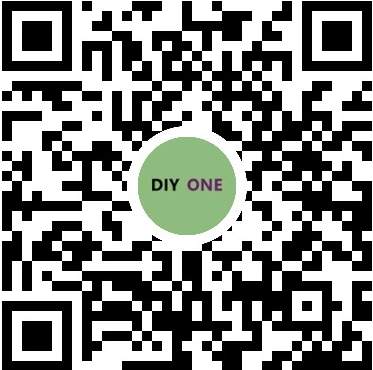
兔子在叢林——劉賓作品展
文/劉振
美術(shù)學(xué)博士、天臺(tái)山文化研究院研究員
讀小人書是童年時(shí)的一大樂事,雖然那時(shí)候還不識(shí)字,卻也看得津津有味。由于不認(rèn)識(shí)畫面下方的文字,我們發(fā)揮想象,把一頁一頁的畫面重新“編”成一個(gè)故事,甚至把自己也“編”故事里。

對(duì)于童年的心靈來說,生活的每一頁畫面下面,都是大人們的話語。對(duì)這些話語,我們也不甚明了。結(jié)果,我們無意間磨練出的想象力就派上用場(chǎng),把生活的畫面也編成故事,我們就在故事里。
有時(shí),我們甚至完全不需要現(xiàn)實(shí)的畫面,就能編出一兩段故事了。故事都是白日夢(mèng),我們卻總是瞪圓了眼睛做這個(gè)夢(mèng)。這是我們自由的領(lǐng)地,異想天開、無拘無束,是大人們不知道的所在。這樣的領(lǐng)地,甚至?xí)K其一生珍藏在我們的心靈,不向任何人打開。

這似乎是不需外學(xué)的本能,在我們長(zhǎng)大后也能發(fā)揮作用。每幅生活畫面的下面,并不都有文字、話語的說明,即便有,也往往很不充分。這倒重新激發(fā)了我們的想象,把生活編成一個(gè)像樣的故事。生活充滿了束縛,卻也到處是自由的領(lǐng)地。生活中不能沒有別人,我們卻總有別人進(jìn)不到的地方。得意!

儒家的教誨是“慎獨(dú)”,即便獨(dú)處時(shí)也應(yīng)自律。但是在這沒有充分說明的生活中,哪里才算是獨(dú)處的地方呢?也許正是這個(gè)我們自由的地方。我們是自由的,我們珍惜這種自由,舍不得讓人知道,這也是慎獨(dú)。

我們獨(dú)處在滿是別人的地方。我們還可以對(duì)這個(gè)地方盡情地“裝飾”,裝飾上千奇百怪,蛇、骷髏、小河,召之即來,無需備案,也不用任何文字、話語綴在畫面下面。這裝飾是自由的,不受文字、話語的約束。
我們甚至不受自己的約束。藏在這些裝飾里,藏在自己創(chuàng)作的畫面里,藏在叢林中,藏在兔子的面具下。是我們藏著么?還是我們本來就和叢林是一體的?也許我們本來就是叢林里的兔子。

對(duì)于從鄉(xiāng)下遷到城里的小孩來說,更是如此。鄉(xiāng)間的叢林變成了水泥森林,水草的味道變成了煤塵的味道。那些在鄉(xiāng)間編成的故事,突然間全不適用了。那個(gè)自由的領(lǐng)地還在么?小孩總是倔強(qiáng)的,不愿舍棄那鄉(xiāng)間的故事,就先在心里收藏起那勃勃的生機(jī),然后對(duì)城市另起爐灶。
我們竟然似乎有了兩塊自由的領(lǐng)地,多么奇怪!究竟哪一塊才真正是我們的呢?我們也許會(huì)從一塊遷到另一塊,或者今天藏在這一塊,明天藏在另一塊,自由的遷徙在自由的領(lǐng)地,又似乎是不得不遷徙。每一塊都是自由的,卻又互不相屬,自由在這里斷裂了。我們還自由么?
不僅是兩塊領(lǐng)地,好像連小孩的心也成了兩顆。一顆藏著鄉(xiāng)間的故事,這顆心永遠(yuǎn)保留在了童年;一顆編者城里的故事,半路出家地成長(zhǎng)著。哪一顆是真的呢?抑或是不一不異、不斷不常,這也許只有那雙佛眼能看到。
可是,對(duì)于那鄉(xiāng)間成長(zhǎng)過的孩子來說,倒寧愿藏在那已經(jīng)消失的畫面里吧。
2011-11-21
Rabbit in the Jungle
Reading comic books is a great delight of childhood. Although we were illiterate at that time, we read with relish. Not knowing the text below the picture, we recompiled pages of pictures into a new story with imagination, and even put ourselves in the story.
For the soul of childhood, adults' words were at the bottom of each page of life scenes. We were not clear about these words. As a result, the imagination we inadvertently honed came in handy. We compiled scenes of life into a story, and we were in the story.
Sometimes, we didn't even need a realistic picture to create one or two stories. The stories were daydreaming, but we dreamed with eyes wide open. This was our free territory where we were whimsical and unrestrained, and it was a place unknown to the adults. Such territory might even be a lifetime treasure in our hearts, unrevealed to anyone.
It seems an instinct which also plays a role after we grow up. There aren't always texts or explanations below each scene of life. Even there is, it is often very inadequate. This stimulates our imagination to make life into a decent story. Life is full of constraints as well as freedom. We can't live without others, but we can always have a private place. Proud!
Confucianism instructs us to be "discreet in privacy", i.e. to have self-discipline even when alone. But in the life without full description, where is the place to be alone? Maybe it is the place where we are free. We are free and we cherish this freedom, could not bear to let people know. This is also self-discipline.
We are alone in a place full of others. We can also luxuriate in "decorating" it with strange things such as snake, skull and creek. They can be ready at a moment's notice without being put on records or attached with any texts or words. The decoration is free, unbound by texts or words.
We are not even bounded by ourselves. We hide in these decorations, in pictures we create, in the jungle and under the masks of rabbits. Are we hidden? Or are we essentially part of the jungle? Maybe we are originally rabbits in the jungle.
This is especially true for children who move from the countryside to the city. The jungle of the countryside turns into a cement forest, and the smell of aquatic plants becomes that of coal dust. The stories made up in the countryside are suddenly not applicable. Is that free territory still there? Children are always stubborn, unwilling to give up rural stories. So they first collect the vigorous vitality in the heart, and then start all over again in the city.
We seem to have two free territories, how strange! Which on earth truly belongs to us? We may move from one to another, or hide in this one today and in the other tomorrow. We migrate freely between free territories, yet we seem to be forced to do so. Both of the territories are free, yet not belong to each other. Freedom cracks here. Are we still free?
It's not just about two territories. Even the children seem to have two hearts. One conceals stories in the countryside and forever remains in the childhood, while the other makes up stories in the city and grows from halfway. Which one is true? Or neither is real or permanent? It maybe takes a Buddha to see.
However, for children who grow up in countryside, I guess they would rather hide in the picture that has disappeared.
Liu Zhen
November 21, 2011
兔子在叢林 —— 劉賓作品展
學(xué)術(shù)主持 / 楊維民
策展人 / 雷祺發(fā)
藝術(shù)總監(jiān) / 古偉碧
開幕時(shí)間:2017年10月14日下午16:00
展覽時(shí)間:2017年10月14日—10月29日
展館:北京虹墻畫廊
地址:北京市朝陽區(qū)酒仙路大山子798藝術(shù)區(qū)南門陶瓷二街
Moderator / Yang Weimin
Curator / Lei Qifa
Art Director / Gu Weibi
Openg Time : At 16p.m On October 14 , 2017
Exhibition Time : October 14 , 2017—29
Gallery : Beijing Rainbow Wall Art Gallery
Address : Ceramic Second Street , 798 ArtZone , Jiu xian qiao Road , Chaoyang District Beijing , China






 皖公網(wǎng)安備 34010402700602號(hào)
皖公網(wǎng)安備 34010402700602號(hào)